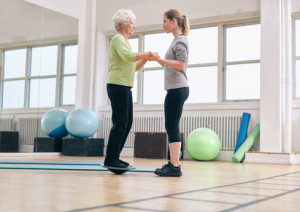 Challenges with balance and stability can happen to all of us as we get older, but is certainly more prevalent in our Parkinson’s community. Maintaining lower body strength in conjunction with balance is very important as it decreases one’s chances of falling. Balance is defines as the state of having your weight spread equally so you do not fall; stability is the quality or state of something that is not easily moved. In order to maintain balance and stability, we need to have our center of gravity over a strong base of support. If your center of gravity standing upright is the area of your belly button – then your feet are your base of support. Standing with both feet on the ground spread just past shoulder width offers a stronger base of support than standing on one leg or with your feet very close together.
Challenges with balance and stability can happen to all of us as we get older, but is certainly more prevalent in our Parkinson’s community. Maintaining lower body strength in conjunction with balance is very important as it decreases one’s chances of falling. Balance is defines as the state of having your weight spread equally so you do not fall; stability is the quality or state of something that is not easily moved. In order to maintain balance and stability, we need to have our center of gravity over a strong base of support. If your center of gravity standing upright is the area of your belly button – then your feet are your base of support. Standing with both feet on the ground spread just past shoulder width offers a stronger base of support than standing on one leg or with your feet very close together.
There are many issues that can affect your ability to balance yourself while standing or walking. Trouble with vision, lack of lower body strength, poor posture, medications, low blood pressure, and inability to properly lift our feet are all contributors. So how can you better prepare yourself to stay strong on your feet?
Slow Rise: When standing up from a chair or rising out of bed – do so slowly and wait about 5 seconds before you begin to walk. This enables your body to adjust to the change of position.
Hands Free: Keep at least one hand free at all times while walking – carrying an object with both hands can interfere with your ability to balance.
Arm Swing: Attempt to swing both arms from front to back while walking – this also helps maintain an upright posture and reduces fatigue.
Walk Consciously: Always strive to consciously lift your feet off the ground while walking; a shuffling gait can cause one to trip.
Make a U-Turn: When trying to navigate a turn while walking, use a “U” technique of facing forward and making a wide turn as opposed to pivoting sharply.
Helping Aides: Don’t be intimidated by canes, walking sticks, walkers or grab bars. These helpful devices can keep you safe and prevent a fall.
Keep it Simple: Only do one thing at a time when you are on your feet. Using a phone, gazing around, or even drinking a beverage can be a distraction and affect your balance.
In addition to taking these steps to maintain your balance and stability – take precautions in your home to make it safe. Loose throw rugs, scurrying pets, wet bathtubs and slippery staircases can cause danger in your home and throw even the most strong and stable person off balance. Also, working with a fitness professional to strengthen your stomach and leg muscles will help keep you more stable and lessen your likelihood of falling if you were to lose your balance. A strong body is a more stable body!
Carisa Campanella, BA, AS, is an ACE Health Coach and ACSM Personal Trainer. She is the Program Manager at the Neuro Challenge Foundation for Parkinson’s. Neuro Challenge provides ongoing monthly support groups and educational programs, individualized care advising and community resource referrals to help empower people with Parkinson’s and their caregivers.
